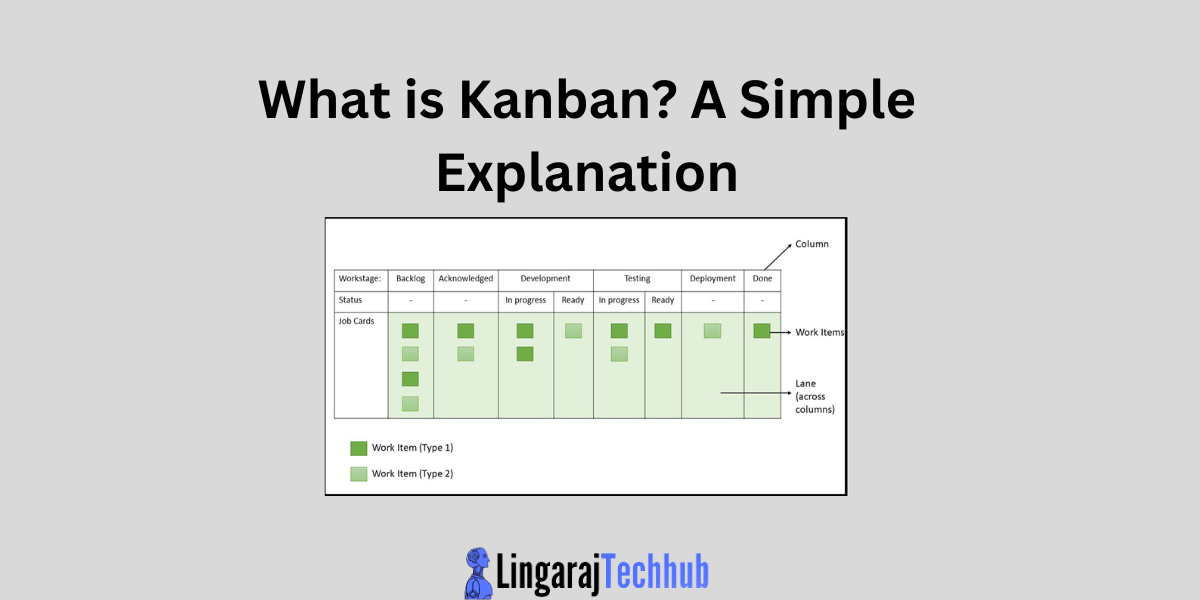What is Kanban? A Simple Explanation
 LingarajTechhub All About Programming
LingarajTechhub All About Programming
Kanban is a popular Agile method that helps improve workflow and team productivity. It focuses on visualizing tasks, limiting work in progress, and managing flow to make processes more efficient. Here's a simple guide to the Kanban method:
1. Visualize the Workflow
Create a Kanban Board: The Kanban board is the main tool. It shows how work items move through different stages of the process.
Define Columns: Split your workflow into stages like "To Do," "In Progress," "Review," and "Done." Each stage is a column on the board.
Use Cards: Each task or project is shown as a card on the board. Cards move from left to right as they go through the workflow.
2. Limit Work in Progress (WIP)
Set WIP Limits: Assign a maximum number of tasks that can be in each column simultaneously. This prevents overloading the team and helps maintain focus.
Manage Flow: By limiting WIP, the team can identify bottlenecks and inefficiencies more easily. It encourages finishing tasks before starting new ones.
3. Manage Flow
Monitor and Measure Flow: Watch how cards move across the board to see how work is progressing. Note how long tasks stay in each column.
Identify Bottlenecks: If tasks are stuck in one stage, find out why and fix the issue to improve flow.
Optimize Process: Always look for ways to make the workflow smoother and better based on what you learn from tracking the flow.
4. Make Process Policies Explicit
Define Clear Rules: Establish clear policies for how work items move from one stage to another. These rules should be agreed upon by the team.
Communicate Policies: Ensure that all team members understand and follow the established policies. This helps maintain consistency and accountability.
5. Implement Feedback Loops
Conduct Regular Meetings: Use meetings like stand-ups, retrospectives, and reviews to gather feedback, discuss progress, and identify areas for improvement.
Incorporate Feedback: Use the feedback from these meetings to refine the process, adjust WIP limits, or modify workflow stages.
6. Improve Collaboratively and Evolve Experimentally
Foster a Culture of Continuous Improvement: Encourage the team to suggest and try small changes to the process. Experiment with different methods to find what works best.
Use Metrics: Track key performance indicators (KPIs) like cycle time (how long it takes to finish a task) and throughput (the number of tasks finished in a set time) to measure improvement.
7. Deliver Incrementally
Focus on Delivering Value: Prioritize tasks that provide the most value to customers or stakeholders. Aim to deliver high-quality work consistently.
Maintain Flexibility: Kanban lets the team change priorities as needed, so they can adapt to new demands without disrupting the workflow.
8. Review and Reflect
Analyze Performance: Regularly review the team's performance using metrics and feedback from the board.
Adapt and Evolve: Based on the insights gained, make necessary adjustments to the process, board design, or WIP limits.
Conclusion
The Kanban methodology is a flexible and visual way to manage work that promotes ongoing improvement and adaptability. By focusing on flow, limiting work in progress, and using feedback based on data, teams can become more productive and efficient.
Subscribe to my newsletter
Read articles from LingarajTechhub All About Programming directly inside your inbox. Subscribe to the newsletter, and don't miss out.
Written by

LingarajTechhub All About Programming
LingarajTechhub All About Programming
Corporate Software Development Trainer with a demonstrated track record of success in the IT and Ed-tech industries for product development. I started my career as a software developer and have since taught C, C++, Java, and Python to hundreds of IT enthusiasts, including corporate professionals, throughout the years. I have been developing software for over 12 years.